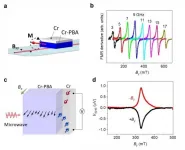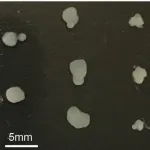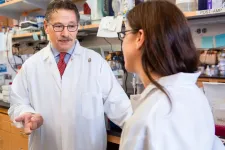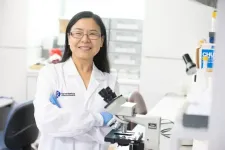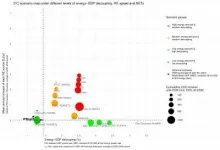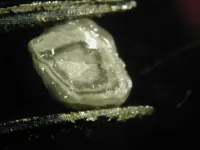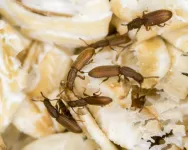Researchers reveal Knl1 gene function in plants
2021-05-11
(Press-News.org) Dr. HAN Fangpu's group from the Institute of Genetics and Developmental Biology of the Chinese Academy of Sciences reports the identification and functional study of the maize Knl1 gene in an article published online in PNAS. The gene is a major component of the KMN network that links centromeric DNA and the plus-ends of spindle microtubules. It also plays an important role in kinetochore protein recruitment.
The kinetochore complex that assembles on the centromeres mediates the proper partitioning of chromosomes to daughter cells during the cell cycle. However, kinetochore proteins undergo frequent mutations and coevolve with their interaction partners, leading to great diversity in kinetochore composition in eukaryotes.
Functional studies of kinetochore composition in plant model organisms are necessary to shed light on the evolutionary role of this intriguing component, and thus improve our collective understanding of the fundamentals of genetics.
The Knl1 is the constitutive component of the central kinetochore protein in plants. The researchers showed it was subcellularly localized and colocalized with other kinetochore components during interphase, mitosis, and meiosis. The functional importance of Knl1 in plants was demonstrated via characterization of the knl1 mutant.
The researchers revealed that Knl1 plays an essential role in chromosomal congregation and segregation during mitosis in maize, and deficiencies in Knl1 are linked to defective kernel development.
In addition, the researchers shed light on how spindle assembly checkpoint (SAC) proteins interact with kinetochores in plants.
In the present study, the scientists discovered that maize Knl1 interacts with BMF1/2 via a 145-aa region that does not contain well-known MELT repeats described in yeast and mammalian cells. This region displayed high divergence between monocots and eudicots, implying a rapid evolution of kinetochore proteins.
In fact, despite being evolutionarily conserved in function, KNL1 displayed low overall sequence similarity between species. The intricate species-dependent presence/absence of conserved sequence regions led the authors to propose an interaction network model of plant Knl1 with spindle assembly checkpoint signaling.
Understanding the evolutionary and functional importance of these fundamental individual components of the kinetochore complex may in turn improve the efficacy of downstream manipulations, such as the generation of haploid inducer lines for medical applications.
INFORMATION:
[Attachments] See images for this press release:
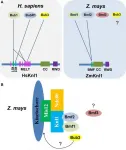
ELSE PRESS RELEASES FROM THIS DATE:
2021-05-11
A team of researchers, affiliated with UNIST has recently introduced a new class of magnetic materials for spin caloritronics. Published in the February 2021 issue of Nature Communications, the demonstrated STE applications of a new class of magnets will pave the way for versatile recycling of ubiquitous waste heat. This breakthrough has been led by Professor Jung-Woo Yoo and his research team in the Department of Materials Science and Engineering at UNIST.
Spin thermoelectrics is an emerging thermoelectric technology that offers energy harvesting from waste heat. ...
2021-05-11
Like many around the world, the lab of Professor Mriganka Sur in The Picower Institute for Learning and Memory at MIT has embraced the young technology of cerebral organoids, or "minibrains," for studying human brain development in health and disease. By making a surprising finding about a common practice in the process of growing the complex tissue cultures, the lab has produced both new guidance that can make the technology better, and also new insight into the important roles a prevalent enzyme takes in natural brain development.
To make organoids, scientists take skin cells from a donor, induce them to become stem cells and then culture those in a bioreactor, guiding their development with the addition of growth ...
2021-05-11
COLUMBUS, Ohio - People are more persuaded by the actual messages contained in social media posts than they are by how many others viewed the posts, a new study suggests.
Researchers found that when people watched YouTube videos either for or against e-cigarette use, their level of persuasion wasn't directly affected by whether the video said it was viewed by more than a million people versus by fewer than 20.
What mattered for persuasion was viewers' perception of the message as truthful and believable.
"There wasn't a bandwagon effect in which people were persuaded by a video just because ...
2021-05-11
An international team of researchers at Great Ormond Street Hospital (GOSH), and University of California, Los Angeles (UCLA) have developed a gene therapy that successfully treated 48 out of 50 children with a form of severe combined immunodeficiency that leaves them without an immune system.
Severe combined immunodeficiency due to adenosine deaminase deficiency, also known as ADA-SCID, is a rare, life-threatening disease that prevents children from living a normal life. It is caused by mutations in the gene that creates the enzyme adenosine deaminase, which is essential to a functioning immune system.
Children with ADA-SCID have no immune system and, if left untreated, the condition can be fatal within the first two years of life. Day-to-day activities ...
2021-05-11
An experimental form of gene therapy developed by a team of researchers from UCLA and Great Ormond Street Hospital in London has successfully treated 48 of 50 children born with a rare and deadly inherited disorder that leaves them without an immune system.
Severe combined immunodeficiency due to adenosine deaminase deficiency, or ADA-SCID, is caused by mutations in the ADA gene that creates the enzyme adenosine deaminase, which is essential to a functioning immune system. For children with the condition, even day-to-day activities like going to school or playing with friends can lead to dangerous, life-threatening infections. If untreated, ADA-SCID can be fatal within the first two years of life.
The investigational gene therapy method involves first collecting ...
2021-05-11
CAMBRIDGE, MA -- In early 2020, a few months after the Covid-19 pandemic began, scientists were able to sequence the full genome of the virus that causes the infection, SARS-CoV-2. While many of its genes were already known at that point, the full complement of protein-coding genes was unresolved.
Now, after performing an extensive comparative genomics study, MIT researchers have generated what they describe as the most accurate and complete gene annotation of the SARS-CoV-2 genome. In their study, which appears today in Nature Communications, they confirmed ...
2021-05-11
A receptor that helps conserve energy when food is scarce may be the key to a safer approach to treating diet-induced obesity, research led by the Garvan Institute of Medical Research has revealed.
In a study using experimental models and fat tissue biopsies from obese individuals, the team revealed that blocking a specific receptor of the molecule neuropeptide Y (NPY), which helps our body regulate its heat production, could increase fat metabolism and prevent weight gain.
"The Y1 receptor acts as a 'brake' for heat generation in the body. In our study, we found that blocking this receptor in fat tissues transformed the 'energy-storing' fat into 'energy-burning' fat, which ...
2021-05-11
The first comprehensive comparison of 'degrowth' scenarios with established pathways to limit climate change highlights the risk of over-reliance on carbon dioxide removal, renewable energy and energy efficiency to support continued global growth - which is assumed in established global climate modelling.
Degrowth focuses on the global North and is defined as an equitable, democratic reduction in energy and material use while maintaining wellbeing. A decline in GDP is accepted as a likely outcome of this transition.
The new modelling by the University of Sydney and ETH Zürich includes high growth/technological change and scenarios summarised ...
2021-05-11
Diamonds are sometimes described as messengers from the deep earth; scientists study them closely for insights into the otherwise inaccessible depths from which they come. But the messages are often hard to read. Now, a team has come up with a way to solve two longstanding puzzles: the ages of individual fluid-bearing diamonds, and the chemistry of their parent material. The research has allowed them to sketch out geologic events going back more than a billion years--a potential breakthrough not only in the study of diamonds, but of planetary evolution.
Gem-quality diamonds are nearly pure lattices of carbon. This elemental purity ...
2021-05-11
Saw-toothed grain beetles live in a symbiotic association with bacteria. Their bacterial partners provide important building blocks for the formation of the insect's exoskeleton, which protects the beetles from their enemies as well as from desiccation. In a new study, a team of scientists from the Johannes Gutenberg University in Mainz, the Max Planck Institute for Chemical Ecology in Jena, and the National Institute of Advanced Industrial Science and Technology in Japan demonstrates that glyphosate inhibits the symbiotic bacteria of the grain beetle. Beetles exposed to the weedkiller no longer receive the building blocks they need from the bacteria. The study shows that glyphosate has the potential to harm insects indirectly by targeting their bacterial partners ...
LAST 30 PRESS RELEASES:
[Press-News.org] Researchers reveal Knl1 gene function in plants

